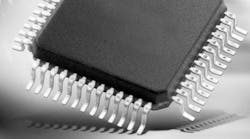Today’s demand for energy efficiency is a driving force in the microcontroller market, as suppliers strive to deliver new and better solutions that reduce power consumption and help designers get even more performance out of their products. A combined desire to “go green” and become even more mobile with our technology is behind the trend, say industry leaders.
“We’re seeing a continued push to reduce power consumption,” says Mike Scott, vice president of semiconductors for components distributor Mouser Electronics. “As products get smarter and more feature rich, it’s really critical that not only the processor but every other component in their design becomes much more green, much more energy efficient.”
Scott points to examples in the industrial and medical markets. The motors, fans, and communication protocols in equipment throughout a manufacturing plant, for example, require more and more processing power while limiting any increase in energy consumption.
Component manufacturers have responded with ultra-low-power microcontrollers that use considerably less energy than previous devices. Texas Instruments’ MSP430 family of ultra-low-power microcontrollers, for instance, feature larger memory, display drivers, and analog peripherals and yield better performance and higher precision in a variety of applications.
“[Manufacturers] are really pushing the envelope to drive power consumption down,” Scott explains. “Even with a motor, it’s about making the motor run much more efficiently than it has in the past.”
And as pricing has come down, many designers are looking to migrate from 8-bit microcontrollers to 16-bit or 32-bit models to add more functionality to their products. Blood pressure monitors are a good example. Simple versions may require a 4-bit or 8-bit microcontroller. But with more power, designers are creating smarter versions that don’t just monitor pressure, but store results, connect to a personal computer for downloading information, and even allow users to send results directly to their doctor via a built-in wireless connection.
“You can’t do all that with an 8-bit processor,” Scott adds.
Partnering For Success
High performance and low power consumption are driving new manufacturer-distributor partnerships as well. Over the summer, distributor Newark element14 announced its collaboration with semiconductor manufacturer Freescale, in which the distributor offered pre-ordering of Freescale’s new Freedom development platform for the Kinetis L series 32-bit MCUs. Freescale introduced the Kinetis L series in June.
Newark element14 was the only distributor to offer pre-ordering of the board, which is available this month. The high-performance, low-power solution is ideal for developing mobile applications in a variety of end markets, including medical, consumer electronics, lighting, and energy, says Jeff Jussel, senior director of technical marketing for Newark element14.
“Compared to other processors out there, this can run things a heck of a lot faster and it also will go a long time on a little bit of power,” explains Jussel, adding that the Freedom development board aims to speed adoption of the Kinetis L series. The board’s low cost, around $12, is another key factor.
“[This is] good for anyone who wants to upgrade from an 8- or 16-bit processor to 32-bit performance,” adds Jussel. “The board and the applications around it will help people migrate their applications even faster.”
The move is part of element14’s strategy to provide a more complete solution to design engineers. Designers can get technical assistance and product information, along with additional design tools, in one place: element14’s design center, the Knode. Freescale and element14 also offered webcasts on the new technology over the summer as another way to get the word out.
“This is part of our strategy to be a complete solution for designers,” adds Jussel. “This is exactly the type of thing we want to do.”
Distributors focused on the design process expect more of the same customer requirements as technology continues to advance and designers seek to add even more functionality to the electronic devices that are a growing part of everyday life. Scott calls cell phones a prime example.
“For what you do now and you get six or eight hours before your battery wears out, in past lives you would only get 30 to 45 minutes of processing time to do the same things,” says Scott.
Looking ahead, he adds, consumers are only going to want more.








